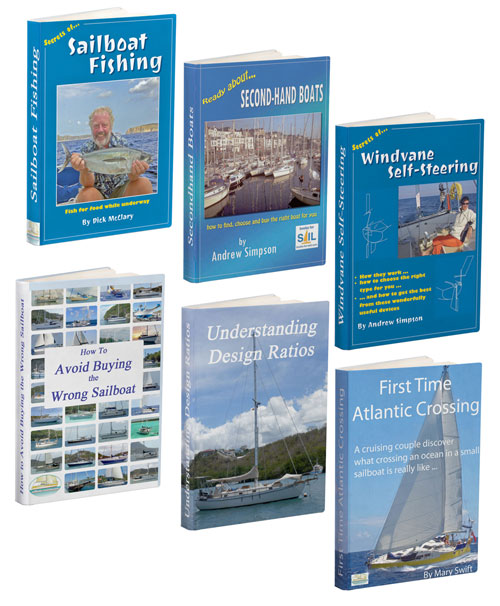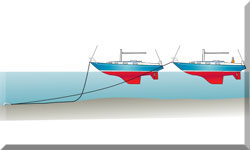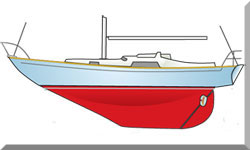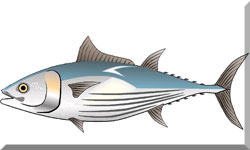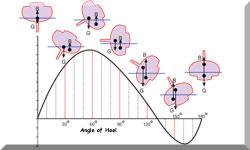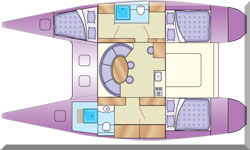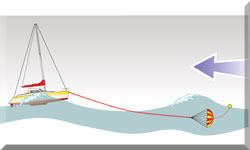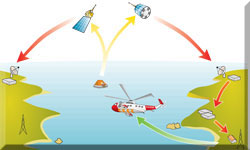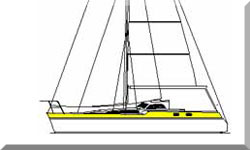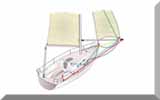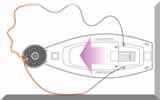- Home
- Electronics & Instrumentation
- SSB Marine Radio
- Vhf Marine Radio
VHF Marine Radio: Practical Information for Skippers & Crew
VHF marine radio is the most popular way of communicating with other vessels and shore stations where the range allows. VHF sets are simple, compact, robust units and, compared to other two-way communication devices, inexpensive.
Radio waves travel in straight lines, which means that "if you can see it, you can talk to it".
So providing there's nothing in the way, like the curvature of the earth or a land mass to deflect it or stop it altogether, range will depend on the respective heights of the transmitting and receiving vhf marine antenna.
On land, coastguards and harbour masters will have theirs at the top of their buildings. On a sailboat there's only one sensible place to fit it; at the top of the mast.
VHF Marine Radio Range
Antenna Height/Range Table
|
2m/4nm 5m/6nm 10m/8nm 15m/10nm 20m/11nm |
25m/13nm 35m/15nm 50m/18nm 75m/22nm 100m/26nm |
The first number is the height of the VHF antenna above sea level in metres (m), and the second is the distance to the horizon in nautical miles (nm).
For example, if your sailboat has its VHF antenna mounted 15m above sea level and another vessel has its 10m above sea level, then you can communicate with each other as long as you're no more than 18 nautical miles apart (10nm + 8nm).
If you're communicating with a shore station with its VHF antenna 100m above sea level, your VHF range would be 36 nautical miles. Similarly, your handheld VHF (2m above sea level) would only have a 12 nautical mile range when communicating with a vessel with its VHF antenna 10m above sea level.
Range is also affected by power, which is measured in watts. Fixed installations can be switched between low power (1w) and high power (25w). For longer range marine communication, you'll need an SSB radio installation.
VHF Frequency Changes
In January 2024, new VHF frequency regulations came into effect, impacting maritime radiocommunication equipment. These changes included revised frequencies and channelling arrangements for maritime VHF bands. While the designated channels for navigation safety, distress communications, and ship-to-ship VHF communications remain unchanged, some coast stations altered their operating channel designations.
To ensure compatibility, vessel owners and operators should verify that their VHF radios can communicate on the updated frequencies. It’s advisable to have at least two VHF radios onboard capable of handling the new frequencies, especially for areas with Vessel Traffic Services (VTS) that may adopt these changes.
Before embarking on a voyage, reviewing the radio channel and frequency requirements for the area of operation is crucial.
Fixed VHF Marine Radio Sets
Most of us opt for one of these located at our boat's navigation station, with an extension speaker mounted in the cockpit.
After many years of reliable service, my ICOM VHF rolled over and died, and I decided to replace it with a Standard Horizon combined VHF/DSC/AIS set.
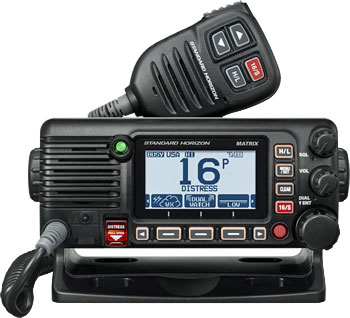 Standard Horizon GX2410GPS Fixed VHF
Standard Horizon GX2410GPS Fixed VHFCoupled to my Raymarine chart-plotter, it displays AIS data of all appropriately equipped vessels on the display. They're obviously a little more expensive than a standard set but a lot cheaper than two individual VHF and AIS sets. It's proved to be a great purchase.
Advanced Features in Modern VHF Radios
Modern VHF radios have evolved significantly, offering features like frequency scanning, weather updates, and GPS integration.
Digital Selective Calling (DSC) allows users to send distress signals with a single button press, transmitting their vessel’s position to nearby vessels and rescue authorities.
GPS integration enhances location tracking, while Automatic Identification Systems (AIS) improve situational awareness and collision avoidance.
For example, the Icom IC-M510 enables smartphone control and intercom functions, allowing up to three smartphones to act as remote controllers. The IC-M94DE, a handheld VHF radio, is the first of its kind with a dedicated AIS receiver. These innovations make communication more efficient and enhance safety at sea.
Handheld Marine VHF Radio
 ICOM-IC-M94
ICOM-IC-M94All cruising boats should carry a handheld VHF marine radio in addition to the fixed installation—ideally a waterproof one that floats. Imagine you're going ashore in the yacht's tender in a brisk offshore wind. The outboard stops, or you drop an oar. Without a handheld VHF set to call for help, you could well find yourself in a spot of bother, particularly if darkness is setting in.
And if it has a built-in GPS receiver, you can tell your rescuers exactly where you are. A handheld VHF radio is also a very useful backup if the fixed VHF set lets you down. Handheld sets normally have power settings of 2.5w and 5w, and some models are now available with DSC (Digital Selective Calling).
International Marine VHF Channels
If you buy a marine VHF radio in the UK today, it will have channels 1 to 28 and 60 to 88. Channels 29 to 36 and 38 to 59 are private channels that you won't have access to. Channel 37 is numbered as 'M' and is used by UK marinas and yacht clubs, along with Channel 80.
Channel 16 is reserved for Initial Calling and for Distress and Safety Calling. Having established contact via Channel 16 in a non-distress situation, the station called will nominate a Working Channel to which both parties will switch for the rest of their communication.
The Working Channels are 06, 08, 09, 10, 13, 15, 17, 67, 69, 72, 73, and 77. Channels 10, 67, and 73 are also used by the UK Coastguard, so it's best to avoid these. Channel 70 is reserved solely for DSC (Digital Selective Calling).
Note that in this case, 'International' doesn't include the United States and Canada; they use different VHF channels 'over there.'
So, for US Yachtsmen...
In the United States and Canada, marine VHF radios operate on a slightly different channel plan. Channels like 22A are designated for Coast Guard communications, which are not available in the International band. Channel 16 remains the primary channel for distress, safety, and calling, while Channel 13 is used for bridge-to-bridge navigation and safety of navigation.
The US also has weather channels (WX1 to WX7) provided by NOAA, which broadcast continuous weather updates and alerts. These channels are invaluable for yachtsmen navigating US waters, offering real-time weather information to ensure safe passage.
Additionally, US yachtsmen should be aware of the distinction between simplex and duplex channels.
- Simplex channels, such as Channel 68, are used for ship-to-ship and ship-to-shore communications, where the same frequency is used for both transmitting and receiving.
- Duplex channels, like Channel 22A, are used for ship-to-shore communications, with separate frequencies for transmitting and receiving. This means you will only hear the shore station on a duplex channel, not other vessels.
When operating in US waters, it’s essential to switch your VHF radio to the US channel mode to ensure compatibility with local regulations and practices. This adjustment is typically straightforward and can be done via the radio's settings menu.
AIS Usage
AIS plays a vital role in collision avoidance and vessel tracking. It provides real-time information about nearby vessels, including their identity, position, and course.
However, not all vessels are equipped with AIS, and some may switch it off under certain circumstances. Users should not rely solely on AIS for navigation and should complement it with radar and visual observations.
Marine VHF Licence Requirements
In the UK you're required by law to have both a Ship Radio License and a VHF/DSC (Short Range) Operators Certificate.
The Ship Radio Licence is free but is required for all VHF marine radios. You can get a Ship Radio Licence right here...
In the United States, recreational boaters navigating domestic waters typically do not need a license to operate a marine VHF radio, radar, or EPIRBs. However, things change if you plan to travel internationally or use specific communication equipment. In these cases, obtaining an FCC Ship Station License is mandatory.
This license allows you to communicate with foreign stations and ensures compliance with international regulations. The application process is straightforward—you need to file FCC Form 605—and the license is valid for ten years, making it a hassle-free, long-term solution for international voyaging.
If you're planning international voyages, such as trips to Canada, Mexico, or the Bahamas, having the correct documentation is crucial. You must carry both a Ship Station License and an operator permit to adhere to international maritime communication standards. This preparation ensures smooth communication and avoids any legal complications while exploring foreign waters.
Misuse of VHF Channels
Improper use of VHF channels can cause interference and jeopardize safety. Channel 16 should only be used for distress, urgency, and brief safety communications. Misuse of this channel can lead to serious consequences, as it is reserved for critical maritime operations.
Educating your crew about proper channel usage is essential to prevent interference and ensure effective communication.
UK VHF Courses
The VHF/DSC (Short Range) Operators Certificate licenses the operator to use the VHF marine radio. You must not send general transmissions on VHF without one. You'll need to attend (and pass) a VHF course to get your hands on one of these.
The VHF Marine Radio Course operated by the RYA is one of the most popular ones, covering:
- the basics of radio operation;
- the correct frequencies (channels) to be used;
- distress, emergency and medical assistance procedures;
- making ship to shore telephone calls;
- Digital Selective Calling (DSC) using simulators;
- Global Maritime Distress and Safety System (GMDSS);
- Emergency Position Indicating Radio Beacons (EPIRB);
- Search and Rescue (SART)
Got a VHF-related question that hasn't been addressed above? Odds are, you'll find the answer here...
Recent Articles
-
Is An SSB Marine Radio Installation Worth Having on Your Sailboat?
Apr 14, 25 02:31 PM
SSB marine radio is expensive to buy and install, but remains the bluewater sailors' favourite means of long-range communication, and here's why -
Correct VHF Radio Procedure: Your Questions Answered
Apr 14, 25 08:37 AM
Got a question about correct VHF radio procedure? Odds are you'll find your answer here... -
VHF Marine Radio; Which One is Right for Your Boat?
Apr 14, 25 05:09 AM
If you're looking to buy a VHF Marine Radio the choice can be a bit overwhelming. So what should it be, a fixed VHF or a handheld VHF? Maybe one with AIS or GPS built in perhaps?
